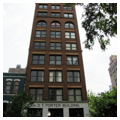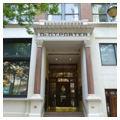You are here
Dr. D. T. Porter Building
Built in 1894–1895 as the Continental National Bank, the D.T. Porter Building is located in the commercial heart of Memphis. It was the first skyscraper in the city and the tallest building south of St. Louis and it had the world’s tallest circulating hot-water system. Once completed, the building attracted tourists willing to pay ten cents to take the elevator to the roof.
Following examples set by 1880s skyscrapers in Chicago, the Porter Building is constructed of a steel frame fireproofed with masonry. Alabama limestone sheaths the first two stories and the remaining floors are clad in brick. Generous windows face Court Square and North Main Street. Atop the structure is an ornate terra-cotta cornice and balustrade.
The Main Street elevation is eleven stories high, though a third of the building is one additional story on the side facing Court Square. The rhythm of the fenestration on this west side is idiosyncratic: the expected grid of square windows is interrupted by an asymmetrical arrangement of rounded arches on the fourth, seventh, and tenth floors. To further break up symmetry, the main entrance—flanked by Corinthian columns of red granite—is located in the fifth of six bays. Stylistically, the building combines elements from the Italian Renaissance and Richardsonian Romanesque.
The building was one of the last works of the architectural firm of Jones, Hain and Kirby. The principal partner, Edward Culliat Jones (1822–1902), was a native of Charleston, South Carolina. Starting his career in 1848, Jones designed Greek Revival houses. After serving in the Confederate army during the Civil War, he settled in Memphis in 1866 and began a long partnership with Mathias Harvey Baldwin (1827–1891). During the 1870s and 1880s, the two partners specialized in large houses and churches. After Baldwin’s death, Jones took on new partners to design this, his only skyscraper for the Continental National Bank.
Continental National Bank did not survive the ravages of the Panic of 1896 and the building sold in 1900 to the heirs of Dr. David Tinsley Porter. A pharmacist, grocer, and businessman, Porter is credited with saving Memphis from the worst of the yellow fever epidemic of 1878–1879 by supervising the improvement of the city’s sewer and sanitation services. When Porter died in 1898 he left money for his family to use as a memorial, which they did in 1900 when they renamed the Continental National Bank building in his honor, adding bold inscriptions on the north facade and over the west entrance.
By 1966 the building was largely abandoned. Ten years later the lowest floor was converted into a short-lived restaurant. The large mural on the windowless south elevation was probably painted about this time. In 1983 the building was renovated and converted into condominiums.
References
Magness, Perre. Good Abode: Nineteenth Century Architecture in Memphis and Shelby County. Memphis: Junior League of Memphis, 1983.
West, Carroll Van, ed. A History of Tennessee Arts. Knoxville: University of Tennessee Press, 2004.
Williamson, James Floyd, Jr., “D. T. Porter Building,” Shelby County, Tennessee. National Register of Historic Places Inventory-Nomination Form, 1976. National Park Service, U.S. Department of the Interior, Washington, DC.
White, James Terry. The National Cyclopedia of American Biography. New York: J. T. White and Company, 1898.
Writing Credits
If SAH Archipedia has been useful to you, please consider supporting it.
SAH Archipedia tells the story of the United States through its buildings, landscapes, and cities. This freely available resource empowers the public with authoritative knowledge that deepens their understanding and appreciation of the built environment. But the Society of Architectural Historians, which created SAH Archipedia with University of Virginia Press, needs your support to maintain the high-caliber research, writing, photography, cartography, editing, design, and programming that make SAH Archipedia a trusted online resource available to all who value the history of place, heritage tourism, and learning.






